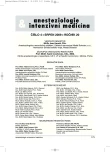Early identification of critically ill patients with the MEDICAL EMERGENCY SYSTEM in St. Ann University Hospital, Brno
Authors:
Pavlík Martin; Dadák Lukáš; Zvoníček Václav; Štětka Pavel; Bartošík Tomáš; Suk Pavel; Šrámek Vladimír
Authors‘ workplace:
Anesteziologicko-resuscitační klinika, Fakultní nemocnice u svaté Anny v Brně a Lékařská fakulta MU
Published in:
Anest. intenziv. Med., 20, 2009, č. 4, s. 185-191
Category:
Intensive Care Medicine - Original Paper
Overview
Objective:
To introduce the Medical Emergency Team in St. Ann University Hospital Brno and to determine its effect on the outcome of patients admitted to the ICU.
Design:
Prospective before-and-after intervention trial in the University Hospital.
Methods:
We studied the patients admitted to the ICU from within the hospital before the introduction of the MET call system (group P, n = 115, September 2005–February 2006), during the „intervention period“ (group S, n = 462, June 2006–July 2008) and the patients admitted through the MET call system (group M, n = 76, June 2006– July 2008).
Results:
There were 433 MET calls made, resulting in 76 patients being admitted to the ICU (17.5%) and 36 patients to the HDU (8.3%). Forty six patients died (10.6%). The most frequent criteria for the MET call were low oxygen saturation (24%), dysrhythmias (16%), blood pressure disturbance (16%), GCS drop (15%) and respiratory rate abnormalities (14%). We observed no difference in the short-time mortality between the groups of patients admitted to the ICU before the MET introduction (23%), after the MET introduction (23%) and the patients admitted through the MET system (27%). There was no significant difference in the ICU length of stay between the three groups.
Conclusion:
The introduction of the MET call system had no positive influence on the short-term mortality and the length of stay of the patients admitted to the ICU through this system.
Keywords:
Medical Emergency System – Rapid Response System – ICU mortality – morbidity
Sources
1. Lee, T. H. A broader concept of medical errors. N. Engl. J. Med., 2002, 347, p. 1965–1967.
2. Buist, M. D., Jarmolowski, E., Burton, P. R., Bernard, S. A., Waxman, B. P., Anderson, J. Recognizing clinical instability in hospital patients before cardiac arrest or unplanned admission to intensive care. Med. J. Aust., 1999, 171, p. 22–25.
3. Franklin, C., Mathew, J. Developing strategies to prevent in-hospital cardiac arrest: analyzing responses of physicians and nurses in the hours before the event. Crit. Care Med., 2004, 22, p. 244–247.
4. Hillman, K. H., Bristow, P. J., Chey, T. et al. Duration of life-threatening antecedents prior to intensive care admission. Intensive Care Med., 2002, 28, p. 1629–1634.
5. Bedell, S. E., Deitz, D. C., Leeman, D. et al. Incidence and characteristics of preventable iatrogenic cardiac arrests. JAMA, 1991, 265, p. 2815–2820.
6. Smith, A. F., Wood, J. Can some in-hospital cardio-respiratory arrests be prevented? A prospective survey. Resuscitation, 1998, 37, p. 133–137.
7. Hillman, K. M., Bristow, P. J., Chey, T. et al. Antecedents to hospital deaths. Intern. Med. J., 2001, 31, p. 343–348.
8. Franklin, C., Mathew, J. Developing strategies to prevent inhospital cardiac arrest: Analyzing responses of physicians and nurses in the hours before the event. Crit. Care Med., 1994, 22, p. 244–247.
9. Leape, L. L., Brennan, T. A., Laird, N. et al. The nature of adverse events in hospitalized patients: results of the Harvard medical practice study II. N. Engl. J. Med.,1991, 324, p. 377–384.
10. Wilson, R. M., Harrison, B. T., Gibberd, R. W. et al. An analysis of the causes of adverse events from the quality in Australian health care study. Med. J. Aust., 1999, 170, p. 411–415.
11. Devita, M., Bellomo, R., Hillman, K. et al. Findings of the First Consensus Conference on Medical Emergency Teams. Crit. Care Med., 2006, 34, p. 2463–2478.
12. Blow, O. et al. The golden hour and the silver day: detection and correction of occult hypoperfusion within 24 hours improves outcome from major trauma. J. Traum., 1999, 47, p. 964–969.
13. Rivers, E. et al. Early goal-directed therapy in the treatment of severe sepsis and septic shock. N. Engl. J. Med., 2001, 345, p. 1368–1377.
14. Rinaldo Bellomo, M. D., Donna Goldsmith, R. N., Shigehiko Uchino et al. Prospective controlled trial of effect of medical emergency team on postoperative morbidity and mortality rates. Crit. Care Med., 2004, 32, p. 916–921.
15. Buist, M., Nguyen, T., Moore, G., Bernard, S., Anderson, J. Association between clinically abnormal bedside observations and subsequent in-hospital mortality: a prospective study. Resuscitation, 2004, 62, p. 137–141.
16. Lundberg, J. S., Perl, T. M., Wiblin, T. et al. Septic Shock: an analysis of outcomes for patients with onset on hospital wards versus intensive care unit. Crit. Care Med., 1998, 26, p. 1020–1024.
17. Buist, M., Moore, G. E., Bernard, S. A. et al. Effects of a medical emergency team on reduction of incidence of and mortality from unexpected cardiac arrests in hospital: preliminary study. BMJ, 2002, 324, p. 387–390.
Labels
Anaesthesiology, Resuscitation and Inten Intensive Care MedicineArticle was published in
Anaesthesiology and Intensive Care Medicine

2009 Issue 4
Most read in this issue
- The utilization of fiberoptic bronchoscopy in intensive care
- A patient with severe and protracted hypoglycaemia
- Early identification of critically ill patients with the MEDICAL EMERGENCY SYSTEM in St. Ann University Hospital, Brno
- Measurement of trans-alveolar pressure with a pulmonary artery catheter
